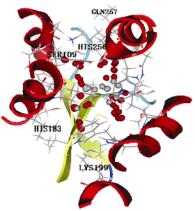1 Du, X.-K.; Li, B. J. Liaoning Univ. Trad. Chin. Med. 2008,10(12), 18 (in Chinese). (杜杏坤, 黎波, 辽宁中医药大学学报, 2008, 10(12), 18.)2 Lu, J.-J. J. Guangzhou Univ. Trad. Chin. Med. 2008, 25(2),180 (in Chinese). (卢建军, 广州中医药大学学报, 2008, 25(2), 180.)3 He, Q.-Y. Ph.D. Dissertation, Beijing University of Traditional Chinese Medicine, Beijing, 2011 (in Chinese). (何庆勇, 博士论文, 北京中医药大学, 北京, 2011)  4 Li, H. M.S. Thesis, Beijing University of Traditional Chinese Medicine, Beijing, 2002 (in Chinese). (李辉, 硕士论文, 北京中医药大学, 北京, 2002) 4 Li, H. M.S. Thesis, Beijing University of Traditional Chinese Medicine, Beijing, 2002 (in Chinese). (李辉, 硕士论文, 北京中医药大学, 北京, 2002)  5 Li, Y.; Wu, Q.; Lin, Q. Chin. J. Basic Med. Trad. Chin. Med. 2010, 16(7), 597 (in Chinese). (李岩, 武乾, 林谦, 中国中医基础医学杂志, 2010, 16(7),597.)6 Wang, C.; Wang, C.-H.; Li, F.; Zhang, C.-X. J. Emerg. Tradit. Chin. Med. 2009, 18(6), 962 (in Chinese). (王超, 王长海, 李锋, 张春许, 中国中医急症, 2009,18(6), 962.)7 Regitz-Zagrosek, V.; Auch-Schwelk, W.; Neuss, M.; Fleck, E. Eur. Heart J. 1994, 15, Suppl D: 92~97.8 Monnot, C.; Bihoreau, C.; Conchon, S.; Curnow, K. M.; Corvol, P.; Clauser, E. J. Biol. Chem. 1996, 271(3), 1507. 5 Li, Y.; Wu, Q.; Lin, Q. Chin. J. Basic Med. Trad. Chin. Med. 2010, 16(7), 597 (in Chinese). (李岩, 武乾, 林谦, 中国中医基础医学杂志, 2010, 16(7),597.)6 Wang, C.; Wang, C.-H.; Li, F.; Zhang, C.-X. J. Emerg. Tradit. Chin. Med. 2009, 18(6), 962 (in Chinese). (王超, 王长海, 李锋, 张春许, 中国中医急症, 2009,18(6), 962.)7 Regitz-Zagrosek, V.; Auch-Schwelk, W.; Neuss, M.; Fleck, E. Eur. Heart J. 1994, 15, Suppl D: 92~97.8 Monnot, C.; Bihoreau, C.; Conchon, S.; Curnow, K. M.; Corvol, P.; Clauser, E. J. Biol. Chem. 1996, 271(3), 1507.  9 http://www.expasy.org/sprot/ 9 http://www.expasy.org/sprot/  10 http://www.ebi.ac.uk/Tools/msa/ 10 http://www.ebi.ac.uk/Tools/msa/  11 Molecular Operation Environment, version 2008.10, Chemical Computing Group Inc., Montreal, Quebec, Canada,2008. 11 Molecular Operation Environment, version 2008.10, Chemical Computing Group Inc., Montreal, Quebec, Canada,2008.  12 http://www.uniprot.org/ 12 http://www.uniprot.org/  13 Miura, S.; Saku, K.; Karnik, S. S. Hypertens. Res. 2003,26(12), 937.14 Li, C.-F.; Gao, D.-S. Medical Recapitulate 2009, 15(13),1932 (in Chinese). (李传方, 高东升, 医学综述, 2009, 15(13), 1932.) 13 Miura, S.; Saku, K.; Karnik, S. S. Hypertens. Res. 2003,26(12), 937.14 Li, C.-F.; Gao, D.-S. Medical Recapitulate 2009, 15(13),1932 (in Chinese). (李传方, 高东升, 医学综述, 2009, 15(13), 1932.)  15 Lorell, B. H. Am. J. Cardiol. 1999, 83(12A), 48H.16 Li, Y.-Q.; Gao, G.-D. J. Xi'an Med. Univ. 1997, 18(2), 275 (in Chinese). (李永勤, 高广道, 西安医科大学学报, 1997, 18(2), 275.) 15 Lorell, B. H. Am. J. Cardiol. 1999, 83(12A), 48H.16 Li, Y.-Q.; Gao, G.-D. J. Xi'an Med. Univ. 1997, 18(2), 275 (in Chinese). (李永勤, 高广道, 西安医科大学学报, 1997, 18(2), 275.)  17 Dai, M.-S.; Zhu, Q.-Y.; Su, D.-F. J. Pharmaceutical Practice1995, 13(3), 141 (in Chinese). (戴生明, 朱铨英, 苏定冯, 药学实践杂志, 1995, 13(3),141.) 17 Dai, M.-S.; Zhu, Q.-Y.; Su, D.-F. J. Pharmaceutical Practice1995, 13(3), 141 (in Chinese). (戴生明, 朱铨英, 苏定冯, 药学实践杂志, 1995, 13(3),141.)  18 Allen, A. M.; Zhuo, J.; Mendelsohn, F. A. Am. J. Hypertens.2000, 13(1 Pt 2), 31S.19 Mukoyama, M.; Nakajima, M.; Horiuchi, M.; Sasamura, H.; Pratt, R. E.; Dzau, V. J. J. Biol. Chem. 1993, 268(33),24539. 18 Allen, A. M.; Zhuo, J.; Mendelsohn, F. A. Am. J. Hypertens.2000, 13(1 Pt 2), 31S.19 Mukoyama, M.; Nakajima, M.; Horiuchi, M.; Sasamura, H.; Pratt, R. E.; Dzau, V. J. J. Biol. Chem. 1993, 268(33),24539.  20 Sasamura, H.; Hein, L.; Krieger, J. E.; Pratt, R. E.; Kobilka, B. K.; Dzau, V. J. Biochem. Biophys. Res. Commun. 1992,185(1), 253. 20 Sasamura, H.; Hein, L.; Krieger, J. E.; Pratt, R. E.; Kobilka, B. K.; Dzau, V. J. Biochem. Biophys. Res. Commun. 1992,185(1), 253.  21 Liu, H.-B.; Cui, W.; Xu, J.; Peng, Y.; Zhou, J.-J.; Xiao, P.-G. Acta Phys.-Chim. Sin. 2010, 26(9), 2549 (in Chinese). (刘海波, 崔巍, 徐峻, 彭勇, 周家驹, 肖培根, 物理化学 学报, 2010, 26(9), 2549.)22 Fu, C.-M.; Zhang, J.-M.; Xu, L.-J.; You, Y.; Fu, X.-H. Asia-Pacific Traditional Medicine 2010, 6(4), 4 (in Chinese). (傅超美, 章津铭, 许丽佳, 游宇, 付薛衡, 亚太传统医 药, 2010, 6(4), 4.) 21 Liu, H.-B.; Cui, W.; Xu, J.; Peng, Y.; Zhou, J.-J.; Xiao, P.-G. Acta Phys.-Chim. Sin. 2010, 26(9), 2549 (in Chinese). (刘海波, 崔巍, 徐峻, 彭勇, 周家驹, 肖培根, 物理化学 学报, 2010, 26(9), 2549.)22 Fu, C.-M.; Zhang, J.-M.; Xu, L.-J.; You, Y.; Fu, X.-H. Asia-Pacific Traditional Medicine 2010, 6(4), 4 (in Chinese). (傅超美, 章津铭, 许丽佳, 游宇, 付薛衡, 亚太传统医 药, 2010, 6(4), 4.)  23 Guharoy, M.; Chakrabarti, P. BMC Bioinformatics 2010, 11,286. 23 Guharoy, M.; Chakrabarti, P. BMC Bioinformatics 2010, 11,286.  24 Wang, L.; Berne, B. J.; Friesner, R. A. Proc. Natl. Acad. Sci. U. S. A. 2011, 108(4), 1326.25 Zoumpoulakis, P.; Daliani, I.; Zervou, M.; Kyrikou, I.; Siapi, E.; Lamprinidis, G.; Mikros, E.; Mavromoustakos, T. Chem. Phys. Lipids 2003, 125(1), 13. 24 Wang, L.; Berne, B. J.; Friesner, R. A. Proc. Natl. Acad. Sci. U. S. A. 2011, 108(4), 1326.25 Zoumpoulakis, P.; Daliani, I.; Zervou, M.; Kyrikou, I.; Siapi, E.; Lamprinidis, G.; Mikros, E.; Mavromoustakos, T. Chem. Phys. Lipids 2003, 125(1), 13.  |
